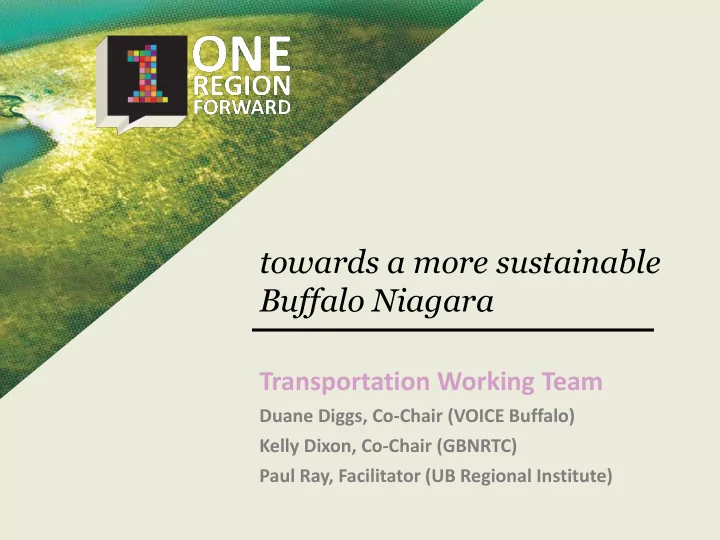

towards a more sustainable Buffalo Niagara Transportation Working Team Duane Diggs, Co-Chair (VOICE Buffalo) Kelly Dixon, Co-Chair (GBNRTC) Paul Ray, Facilitator (UB Regional Institute)
Agenda Introductions and Ice Breaker Review of Process and the working team’s scope and charge Review of key transportation issues Goal Setting Discussion Next Steps
How would you define a sustainable regional transportation system for Buffalo Niagara using one sentence ?
Tasks you will help us with… ESTABLISH FRAME IDENTIFY CONSTRUCT GOALS STRATEGIES ACTIONS INDICATORS for pursuing Align strategies Policies, Create metrics more sustainable to match our programs, and that can measure transportation regional goals projects and the success decisions actors to implement them
Deliverables you will help create… Our Regional Plan for Sustainable Development Our region’s Long Range Transportation Plan – “Buffalo Niagara 2050” Capacity building tools and educational modules that can empower civic leaders and citizens to advance sustainability.
Who will implement our recommendations? Local municipalities, county governments, state or regional agencies (i.e. NFTA) Community Based Organizations and private citizens Private sector actors or businesses (developers, business decision-makers) Collaborative partnerships across these groups
Working Team Process and Timeline
Some key issues to frame our discussion…
Continued maintenance of our transportation infrastructure poses significant fiscal challenges.
Since 1990, we’ve added 525+ miles of new roads Roads Built Since 1990 Roads Built Before 1990
525+ miles Lane Miles Maintenance Total Cost of added Since Cost Per Lane New Lane Miles County 1990 Mile of Roads × = Erie 1,013 $25,328 $25,667,550 × = Niagara 30 $16,166 $491,470 $26,000,000+ added annual tax burden Roads Built Since 1990 Roads Built Before 1990
Vehicle miles travelled per capita keeps growing.
In 1973, vehicles miles travelled daily per capita was 8.25
In 2010, vehicles miles travelled daily per capita was 17.89 An increase of 117%
While connecting workers to jobs via transit is a struggle, access to the transit network is good...
33% of all jobs are reachable via transit in 90 minutes median wait times are 14 minutes during peak rush hour Data Source: Brookings
U.S. Metro Average is 69% Data Source: Brookings, Niagara Frontier Transportation Authority
Our region’s population who own a car enjoy relatively low traffic congestion and short commute times.
And those who own a car enjoy relatively low traffic congestion and short commute times. 3% the congestion of large metros like LA and NYC Source: American Community Survey (2010)
But not everyone has a car, and our region is continuing to age.
Households without a vehicle 13% 9% Buffalo Niagara US
Age Composition of Buffalo Niagara Population 30% 65 and older 25% 55 - 64 20% 15% 10% 5% 0% 1930 1940 1950 1960 1970 1980 1990 2000 2010
Lower traffic congestion and our bi- national location is also a freight opportunity...
Cross-border traffic moving through the Buffalo-Niagara region has diverse U.S. origins and destinations Origin/Destination U.S. Region for 2004 Freight Tonnage Crossing the Lewiston-Queenston Bridge Western / Midwestern USA Rochester 2% 3% New England 4% Pennsylvania Mid-Atlantic 19% USA 11% Ohio Other New York 12% 18% South-eastern USA 13% Buffalo/Niagara 18%
The region has good east-west rail connections
Despite “no - growth” population forecasts, IHS Global Insight forecasts predict that regional freight volume will more than double Freight Tonnage by Mode 400 350 300 250 Millions Air Cargo 200 Maritime Rail 150 Truck 100 50 0 2004 2035 Most of the region’s freight is carried by truck or rail Source: IHS Global Insight TRANSEARCH database
Key issues. Do these data tell the story of our region’s transportation conditions?
Goal Setting, a starting point. Draft goals Do they align with our region’s vision ? Are they current/relevant? Are they long term/resilient? Are they attainable? What’s missing? What shouldn’t be there?
Draft Goals: Transportation & Mobility • Broaden transportation options to promote mobility and access for all, especially young, old, individuals with disabilities, and persons with limited income. • Develop a transportation system that is energy efficient and promotes energy conservation. • Improve public transit service to enhance access to employment, education, health care, and other services. • Maintain and invest in infrastructure and education to foster “Complete Streets.” • Invest in infrastructure to facilitate the movement of freight nationally, bi-nationally, and internationally. • Design and manage our transportation systems to ensure air quality to promote human health.
Transportation and Mobility Working Team Get Started as a Working Team Member at www.oneregionforward.org Recruit a Working Provide Online Feedback on Team Contributor Our Regional Vision and Values
TeamWork Site: https://oneregionforward.teamworkpm.net
TeamWork Site: https://oneregionforward.teamworkpm.net
Transportation and Mobility Working Team If you have any questions, please feel free to contact us Kelly Dixon Teresa Bosch de Celis One Region Forward One Region Forward Project Project Manager Assistant kdixon@gbnrtc.org tboschde@buffalo.edu
Recommend
More recommend